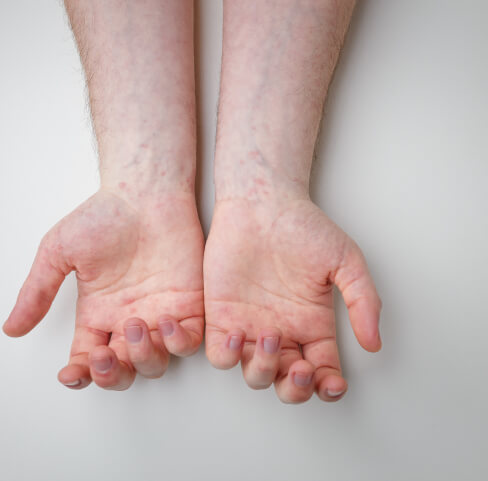
What is EDS
Ehlers-Danlos Syndrome (EDS) is a group of inherited disorders that affect the body’s connective tissues. These tissues provide strength and flexibility to the skin, joints, and blood vessels. In EDS, abnormal collagen causes these tissues to become weak and prone to injury. EDS has multiple types, each with different symptoms and degrees of severity. Common signs across all types include joint hypermobility, skin that stretches more than usual, and fragile tissues.
Book Consultation
Types of EDS
The most prevalent types of EDS are Vascular EDS (vEDS), Classical EDS (cEDS), and Hypermobile EDS (hEDS). Hypermobile EDS is characterized by extremely flexible joints, frequent joint dislocations, and persistent pain. Classical EDS involves highly elastic, soft skin that bruises easily and scars more than usual. Vascular EDS is the most dangerous type, with fragile blood vessels that can rupture, leading to serious complications.
Symptoms of EDS
Symptoms of EDS vary widely, depending on the type and severity. Common symptoms include joint hypermobility, frequent dislocations, and chronic pain. Other signs include stretchy, fragile skin that bruises and scars easily. Some may experience heart valve problems, digestive issues, or early-onset osteoarthritis. Each individual's symptoms can differ greatly.
Joints move beyond the normal range, causing frequent dislocations or subluxations. This affects movement and daily activities.


Diagnosing EDS
Diagnosing EDS involves a detailed clinical evaluation and genetic testing. Doctors assess symptoms, family history, and perform physical exams to check for joint hypermobility and skin elasticity. Genetic tests can confirm the diagnosis, especially for rarer types like vascular EDS.
Book ConsultationTreatment and Management
There is no cure for EDS, but symptoms can be managed effectively. Treatment focuses on preventing injury and managing symptoms through therapy and medication. Regular monitoring by a multidisciplinary medical team is essential for comprehensive care.
Strengthens muscles around joints, improving stability and reducing dislocations. This helps manage joint pain.

Living with EDS
Living with EDS requires ongoing care and lifestyle changes to manage symptoms and prevent complications. Patients often avoid high-impact sports or activities that stress their joints. A strong support network of healthcare providers, family, and patient communities is invaluable. With proper management, many with EDS lead full, active lives. Early diagnosis and intervention are key to better outcomes and improved quality of life.
Why Choose Comfort Clinic?
Comfort Clinic is distinguished by its dedication to providing cutting-edge therapies and outstanding patient empathy. Our team of skilled experts is committed to providing individualized treatment that caters to the particular requirements of every patient. We put safety and effectiveness first, making sure that every treatment is carried out as precisely as possible.
At Comfort Clinic, we use the most recent advancements in medical science and technology to provide the best possible results. Our method is clear-cut and educational, making sure you comprehend every facet of your treatment regimen.
